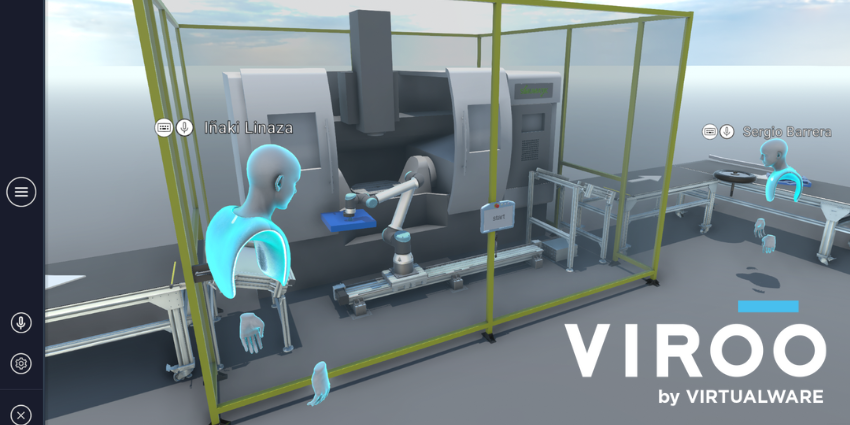Virtualware has recently announced VIROO version 2.6, which is an updated version of the company’s enterprise-grade XR as a Service (XRaaS) platform.
This platform provides multiple ready-to-use applications for users, and tools for developers to create and distribute their own custom multi-user XR applications. VIROO makes it easy to create, distribute, and manage custom XR applications while handling infrastructure updates automatically, allowing organizations to focus on innovation.
The latest version introduces significant updates to the publishing workflow, offering enhanced capabilities for creating multi-scene applications. It provides complete flexibility to configure Unity projects, allowing the inclusion of third-party assets and code libraries, just as in any standard Unity project.
VIROO is designed to provide companies and institutions worldwide with easy access to immersive technology, covering the entire Product Lifecycle Management (PLM) cycle, from concept and design to development and launch, supporting the entire business process.
Alberto Carlier, VIROO’s Product Marketing Manager at Virtualware, spoke exclusively with XR Today to explore VIROO 2.6, its new features, and how the XRaaS platform brings wealth to every stage of product lifecycle deployments.
Introducing VIROO 2.6
Carlier noted that following success deploying previous iterations of VIROO at scale across major global businesses, Virtualware needed to react to the enterprise users and developers demands along with “the arrival of mixed reality,” leading to the team incorporating groundbreaking updates to the publishing workflow and interoperability of the XRaaS platform.
Carlier explained:
We decided that the industry needed a solution that would allow companies to create their own applications and integrate XR more rapidly into each enterprise’s value chain.
By leveraging VIROO as an XRaaS platform, Virtualware enables users to implement XR across all types of workflows and business situations, taking full advantage of XR within their companies.
VIROO allows clients and partners to “create their own custom applications with greater logical depth through VIROO Studio SDK for Unity,” remarked Carlier. With the most recent VIROO 2.6 update, Virtualware introduced “radical changes,” building upon the platform’s legacy.
Carlier remarked that Virtualware calls VIROO XR as a Service “because it’s improving every day, it’s going to be improving in the upcoming months, and it’s going to be getting better and better”. VIROO users do not need to worry about the application or infrastructure upgrades – they happen automatically. This helps organizations to focus on innovation rather than managing technology.
XR is applicable “to many different work processes and all across the value chain of a company, from design and prototyping to commissioning and training” said Carlier.
Enabling Multi-Device Deployment
Carlier noted that while the Virtualware team is a firm believer in and fan of XR headsets, they “know that not many people have them.”
To answer this hardware consideration, VIROO allows for “multi-device compatibility,” Carlier explained.
Carlier added:
No matter what kind of mainstream headset you have—HTC, Pico, Meta Quest or Varjo—or even if you don’t own a headset, if you want to join or create sessions just using your keyboard and mouse on your laptop, you can.
Moreover, VIROO 2.6 can support seamless remote multi-user sessions in different set-ups, connecting workers, while saving time and money on travel.
With VIROO, Carlier notes that businesses can launch and scale XR services quickly while also “reducing the cost and risk” of internal processes.
VIROO aims to support all ranges of XR deployment, cloud and on-premises, and regardless of scope, from big projects with experienced teams to smaller pilot projects with those less experienced in XR.
Carlier added:
It’s so easy to jump into VIROO. You just acquire licenses and start using them on the most compatible devices you may have. If you see the value of it, you can start scaling, buying headsets, buying large-scale immersive rooms, and connecting all across the globe.
Furthermore, developers can also download for free the VIROO Studio SDK for Unity Editor and leverage the multi-user, multi-device and remote collaboration capabilities of their XR applications.
VIROO 2.6 features an extensive and expanding library of enterprise ready-to-use applications. These are designed to meet common user needs and can be implemented immediately, eliminating the need to build custom applications.
Carlier said:
Now, we allow clients to export entire applications and even consume the ones that are already developed. We have a marketplace of VIROO apps. So, even if you don’t know how to create or don’t want to invest in content creation, you can use the ones that are already developed. You can integrate XR into your company way faster than before.
Ensuring Enterprise Security Expectations
Due to the scope of the clients Virtualware works with, the firm is ready for anything, especially commonplace security standards.
Carlier explained that Virtualware and VIROO are ISO 27001 certified, ensuring that all of the company’s internal work processes and its XR platform meet high-security standards.
The update arrives as Virtualware serves major international clients such as GE Vernova, Ontario Power Generation, Gestamp, ADIF, the Spanish Ministry of Defense, and Invest WindsorEssex, assisting each company in utilizing RT3D immersive content today.
We discuss the platform in this video with Alberto Carlier, VIROO’s Product Marketing Manager, Virtualware.







